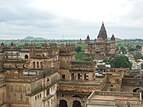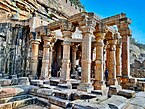This article needs additional citations for verification. (April 2015) |
Bundelkhand (/ˈbʊndeɪlˌkhʌnd/, Hindi: [bʊn.d̪eːl.kʰəɳɖ]) is a geographical and cultural region and a proposed state and also a mountain range in central & North India. The hilly region is now divided between the states of Uttar Pradesh and Madhya Pradesh, with the larger portion lying in the latter state.
Bundelkhand
| |
|---|---|
Top to Bottom; Left to Right: Khajuraho Group of Monuments, Orchha Fort complex, Jhansi Fort, Neelkanth Temple at Kalinjar, Varaha statue at Eran and Raneh Falls | |
 Location of Bundelkhand in India | |
| Coordinates: 25°26′N 78°34′E / 25.44°N 78.57°E | |
| Country | |
| Area | |
• Total | 70,747 km2 (27,316 sq mi) |
| Elevation | 250−300 m (−730 ft) |
| Population (2011) | |
• Total | 18,335,044 |
| • Density | 260/km2 (670/sq mi) |
| Demonym | Bundelkhandi/Bundeli |
| Languages | |
| • Major languages | Bundeli, Hindi |
| Time zone | UTC+05:30 (IST) |
| • Summer (DST) | +05:30 |
| Historical capitals | Banda, Orchha (1501), Panna (1732), Bijawar (1765), Ajaigarh (1765), |
| Separated states | Banda, Orchha, Panna, Bijawar, Ajaigarh, Datia, Khajuraho, Kalinjar, Mahoba, Hamirpur, Charkhari, Jaitpur, Kulpahar, Samthar, Sarila, Gursarai, Barua sagar, Moth, Chirgaon |
Jhansi is the largest city in Bundelkhand. Another major city of Bundelkhand is Sagar being second largest city of Bundelkhand and headquarter of Sagar Division.
Etymology
editBundelkhand means "Bundela domain".[1] The region was earlier known as Jejabhukti or Jejakabhukti ("Jeja's province"). According to the inscriptions of the Chandela dynasty, this name derived from Jeja, the nickname of their ruler Jayashakti. However, it is possible that the name derives from an even earlier name of the region: "Jajhauti" or "Jijhoti". After the Bundelas replaced the Chandelas around 14th century, the region came to be known as Bundelkhand after them.[2]
History
editThe Chandelas were a powerful dynasty in Central India, ruling from the 9th to the 12th century. They are best known for constructing the temples of Khajuraho, a UNESCO World Heritage Site.[3] The Chandelas ruled over a vast territory, and their influence gradually diminished until their eventual fall in 1182 CE.
After the decline of the Chandela, the Khangar community, an ancient Kshatriya clan, established their rule over parts of present-day Bundelkhand from the late 12th century until the mid-14th century.[4] The Khangar dynasty had its seat of power at Garh Kundar, a fort built by Khet Singh Khangar.[4] Their rule over Jujhauti, a region in Bundelkhand, began after the fall of the Chandels in 1182 CE.[4]
By the 14th century, the Bundela dynasty emerged and supplanted the Khangar rulers. Before the advent of British colonial rule in India, the region of Bundelkhand also included several princely states, such as Orchha, Datia, and Samthar.[5] Also, kingdoms such as Damoh, Ramgarh were ruled by Lodhi Rajputs.[6][7]
Proposed Bundelkhand state
editBundelkhand comprises parts of Uttar Pradesh and Madhya Pradesh. While Bahujan Samaj Party government under Mayawati had proposed in 2011 creation of Bundelkhand from seven districts of Uttar Pradesh, organizations such as Bundelkhand Akikrit Party and Bundelkhand Mukti Morcha (BMM) want it to include six districts from Madhya Pradesh as well.[8][9] Uma Bharati of Bharatiya Janata Party has promised separate state of Bundelkhand within three years if her party voted to power, during campaign for Loksabha Election, 2014 at Jhansi.[10] Similar promise was made by Congress leader Pradeep Jain Aditya during Loksabha Election, 2014.[11]
Since the early 1960s there has been a movement for establishing a Bundelkhand state or promoting development of the region. Bundelkhand is geographically the central part of India covering some part of Madhya Pradesh and some part of Uttar Pradesh. (At Sagar is the exact centre of the original undivided India: the granite bench mark by British surveyors indicating this is placed in the compound of a church in Sagar Cantonment.) In spite of being rich in minerals, the people of Bundelkhand are very poor and the region is underdeveloped and underrepresented in state and central politics. There are several local parties and organisations, some promoting further development of the region and some seeking statehood.[12][13] The agrarian crisis and farmers' suicides are also cited as reasons for separate statehood.[14]
In November 2011, the Uttar Pradesh Council of Ministers proposed to split the state into four parts, with one part being Bundelkhand.[15]
Religion
editNotable people
edit- Avantibai, (1831-1858) Lodhi Queen of estate of Ramgarh, one of the key figures in the Indian Rebellion of 1857
- Gopal Bhargava, prominent BJP leader, Senior Most Legislator & Cabinet Minister of Madhya Pradesh
- Uma Bharti, Prominent BJP politician and the former MLA from Charkhari in UP's Bundelkhand region.
- Raja Bundela - (Raja Rajeshwar Pratap Singh Judev) is an Indian actor, producer, politician and civil activist.
- Dhyan Chand, (29 August 1905 – 3 December 1979) army Major and an Indian field hockey player, regarded by many as the greatest field hockey player in history.
- Maharaja Chhatrasal Chhatrasal Bundela was an early modern Indian Rajput king, who fought against the Mughal Empire, and established his own kingdom in Bundelkhand
- Phoolan Devi, (1963–2001) popularly known as "Bandit Queen", was an Indian dacoit and later a politician.
- Raghunath Vinayak Dhulekar MCA & Member of Parliament 1952, MLC & Speaker Vidhan Parishad 1958, social leader
- Rani Durgavati, Queen of Gondwana (born to Chandelas of Mahoba / Kalinjar) immortalised owing to her bravery in defending her kingdom against invasion by Mughal emperor Akbar
- Dr. Hari Singh Gaur, Member of Constitution draft committee and founder of University of Sagar, later named the Dr. Hari Singh Gour University by the state government in 1983.[17]
- Maithili Sharan Gupt, National Hindi poet
- Indeevar, one of the leading Hindi film lyricists in 1960s and 70s[citation needed]
- Jhalkaribai (22 November 1830 – 1858) was an Indian Koli[18] woman soldier who played an important role in the Indian Rebellion of 1857 during the battle of Jhansi.
- Keshavdas (1555 – 1617), usually known by the mononym Keshavdas or Keshavadasa, was a Sanskrit scholar & Hindi poet
- Subodh Khandekar, Olympian hockey player
- Tushar Khandker, player on Indian national hockey team
- Mastani Second wife of Peshwa Bajirao I, the prime minister. Daughter of Maharaja Chhatrasal[19]
- Pankaj Mishra, Indian essayist and novelist
- Joy Mukherjee, Indian actor and director
- Ram Mukherjee, Indian director
- Sashadhar Mukherjee, producer of Hindi films
- Subodh Mukherjee, director, producer, writer of Hindi cinema.
- Harishankar Parsai - a noted satirist and humourist of modern Hindi literature, known for his simple and direct style.
- Nathuram Premi (1881–1960), publisher of Hindi, Sanskrit, Urdu and Jain literature. Independent scholar, Jain historian and editor of several Jain works.
- Rani of Jhansi, (1828–1858) (AKA Lakshmibai Newalkar) Maratha Queen of princely state of Jhansi, one of the key figures in the Indian Rebellion of 1857.
- Rajneesh - Indian godman, mystic, and founder of the Rajneesh movement
- Tatya Tope, freedom fighter, fought in Indian Rebellion of 1857
- Taran Svami, Jain Spritual Leader
- Tulsidas, the author of Ramcharitmanas, born in Rajapur
- Vrindavan Lal Verma, Hindi novelist (Mrig Nayani, Jhansi Ki Rani)
- Maharishi Mahesh Yogi, of Transcendental Meditation
In art and literature
editAn engraving of a picture by Henry Melville entitled Scene near Chillah Tarah Ghaut, Bundelkhund was published in Fisher's Drawing Room Scrap Book, 1835 alongside a poetical illustration by Letitia Elizabeth Landon, Scene in Bundelkhund, which alludes to the desperate conditions in the district due to the famine then prevailing.[20]
The "nearly independent territory of Bundelcund" is featured in Jules Verne's 1872 novel Around the World in Eighty Days, as the scene where Phileas Fogg and Jean Passepartout rescue the Princess Aouda.
Gallery
edit-
Statue of Dhyan Chand on Sipri Hill
-
Rani Durgavati maravi
See also
editReferences
edit- ^ Jain, Ravindra K. (2002). Between History and Legend: Status and Power in Bundelkhand. Orient Blackswan. p. 1. ISBN 978-81-250-2194-0.
- ^ Mitra, Sisirkumar (1977). The Early Rulers of Khajurāho. Motilal Banarsidass. pp. 1–4. ISBN 9788120819979.
- ^ Michell, George (1990). The Penguin Guide to the Monuments of India, Volume 1: Buddhist, Jain, Hindu. Penguin Books. p. 327. ISBN 978-0-14-008144-2.
- ^ a b c Mittal, J. P. (2003). History of Ancient India: A New Version. Atlantic Publishers & Distributors. p. 272. ISBN 978-8126906154.
- ^ Hunter, William Wilson (1885). "Bundelkhand". The Imperial Gazeteer of India. Vol. III (2nd ed.). London: Trübner & Co. p. 150.
- ^ "Bundela Uprising of 1842".
- ^ "Rani Avantibai of Ramgarh".
- ^ "Mayawati's proposal to divide Uttar Pradesh into four States goes far beyond disturbing the State's politics ahead of the elections". The Hindu. Archived from the original on 29 March 2015. Retrieved 4 July 2019.
- ^ "Mayawati-kind-of-Bundelkhand not acceptable: Bundela". Archived from the original on 29 March 2015. Retrieved 30 March 2015.
- ^ "Uma Bharti promises separate Bundelkhand to voters in Jhansi". The Indian Express. 10 April 2014. Retrieved 30 March 2015.
- ^ "LS polls: Pradeep Jain Aditya, Uma Bharti promise separate Bundelkhand state". News18.com. Retrieved 30 March 2015.
- ^ "Demand for separate Bundelkhand reignited ahead of assembly polls separate". Daily.bhaskar.com. 5 April 2013. Retrieved 30 March 2015.
- ^ Atiq Khan (10 December 2009). "Nod for Telangana fuels the demand for Bundelkhand". The Hindu. Retrieved 30 March 2015.
- ^ "Farmers' Suicides and Statehood Demand in Bundelkhand | Economic and Political Weekly". Epw.in. 9 July 2011. Retrieved 30 March 2015.
- ^ "Mayawati wants to divide UP into 4 states, other parties cornered; NDTV". ndtv.com. 16 November 2011. Retrieved 4 August 2015.
- ^ "Census of India". Archived from the original on 10 May 2006.
- ^ "University of Saugar alumniin celebration mode". The Hindu. 18 July 2011. Retrieved 4 August 2015.
- ^ Narayan, Badri (7 November 2006). Women Heroes and Dalit Assertion in North India: Culture, Identity and Politics. SAGE Publications India. ISBN 9788132102809.
- ^ "Bajirao Mastani and the history of Bundelkhand". The Times of India Blog. Retrieved 6 October 2017.
- ^ Landon, Letitia Elizabeth (1834). "picture and poetical illustration". Fisher's Drawing Room Scrap Book, 1835. Fisher, Son & Co.
External links
edit- Check dam project in Bundelkhand (Development Alternatives)
- Historic Blend, Frontline, Volume 24 – Issue 05 :: 10–23 March 2007
- James Foote Holcomb, Helen Harriet Howe Holcomb, In the Heart of India, or, beginnings of missionary work in Bundela Land, with a short chapter on the characteristics of Bundelkhand and its people, and four chapters of Jhansi history. Philadelphia: Westminster Press, 1905 Text at archive.org
- Radio Bundelkhand





